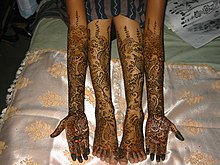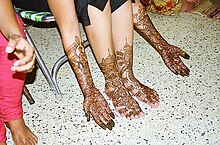|
Mehndi
   Mehndi (ⓘ) is a form of temporary skin decoration using a paste created with henna. In the West, mehndi is commonly known as henna tattoo, although it is not a permanent tattoo.[1] Mehndi is a popular form of body art in South Asia and resembles similar traditions of henna as body art found in North Africa, East Africa and the Middle East. There are many different names for mehndi across the languages of South Asia. There are many different designs and forms of mehndi, often known as henna. For celebrations, women traditionally apply mehndi to their hands and feet, however some people, such as cancer sufferers and women with alopecia, may also decide to adorn their scalps. Rich brown is the most popular henna color, which is produced using a natural dye made from the Lawsonia inermis plant. But modern patterns now incorporate hues like white, red, black, and gold, enabling more individualized and varied artistic expressions. In South Asia, mehndi is applied on the body during both Hindu and Muslim weddings.[2] Hindu women apply mehndi during festivals like Karva Chauth, Vat Purnima, Diwali, Bhai Dooj, Navratri, Durga Puja, and Teej.[3] Muslim women apply mehndi during occasions like Eid al-Fitr and Eid al-Adha.[4] At Hindu and Sikh festivals, women often have henna applied to their hands, feet and sometimes the backs of their shoulders. Conversely, men usually have it applied on their arms, legs, back, and chest. For women, it is usually drawn on their palms, backs of their hands and on feet, where the design will be clearest due to contrast with the lighter skin on these surfaces, which naturally contains less of the pigment melanin.[citation needed]  EtymologyThe origin of "mehndi" is from the Sanskrit word "mendhika," which refers to the henna plant that releases a red dye.[5] According to A Dictionary of Urdu, Classical Hindi and English, mehndi also refers to "the marriage-feast on the occasion of the bride's hands and feet being stained with henna."[5] Origins  Earliest use of henna dye can be traced back to ancient Babylon and Egypt.[6] In 6th century Arabia, its use was well known and used in medicine, overlapping with certain pagan customs in the same historical and cultural context as Islam. In India, it was in use by the 4th century CE, which is evidenced by the cave arts of Deccan region.[6][better source needed]. However, it likely became prevalent around the 12th century CE, aided by the rise of Islam in the subcontinent [7]. ProcessThe paste is made from the powdered dry leaves of the henna plant, Lawsonia inermis.[8] Mehndi paste is usually applied to the skin using a plastic cone, a paintbrush, or a stick. Fifteen to twenty minutes after application, the mud will dry and begin to crack. The painted area is then wrapped with tissue, plastic, or medical tape to lock in body heat, creating a more intense colour on the skin. The wrap, which is not a traditional method, is worn for two to six hours, or sometimes overnight, and then removed. [citation needed] When first removed, the henna design is pale to dark orange in colour and gradually darkens through oxidation, over the course of 24 to 72 hours. The final color is reddish brown and can last anywhere from one to three weeks depending on the quality and type of henna paste applied, as well as where it was applied on the body (thicker skin stains darker and longer than thin skin).[citation needed] Likely due to the desire for a "tattoo-black" appearance, some people add the synthetic dye p-phenylenediamine (PPD) to henna to give it a black colour. PPD may cause moderate to severe allergic reactions when applied to skin.[9] UsageMehndi is a ceremonial art form common in India, Pakistan, Bangladesh, and Afghanistan. It is typically applied during weddings for Sikh, Muslim and Hindu brides. In Rajasthan, the grooms are given designs that are often as elaborate as those for brides. In Assam, apart from marriage, it is broadly used by unmarried women during Rongali Bihu.[citation needed] Among South Asian Muslims, mehndi is a common tradition for brides as well as other girls on weddings. It is also done for Eid on Chaand Raat. There are professionals as well for this while other people do this by their own. Popular mehndi patternsArabic mehndi designsThis pattern is drawn on the palm. Generally, it starts from one corner of the wrist and ends at finger tip on the opposite corner. Vine, lace, and flowers are the main elements of this pattern.[citation needed] Mandala mehndi designsMandala is a geometric configuration of symbols used in various spiritual traditions including Hinduism, Buddhism, Jainism and Shinto. Various configurations of Mandala are drawn on the center of palm in this mehndi pattern.[citation needed] See alsoReferencesWikimedia Commons has media related to Mehndi.
|